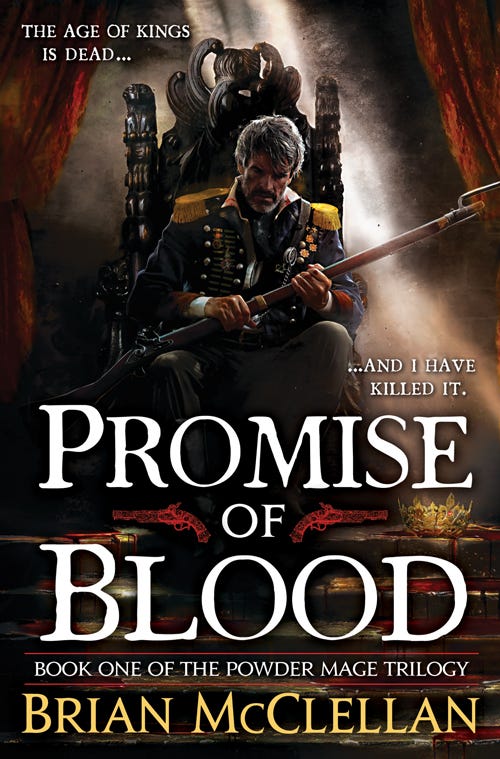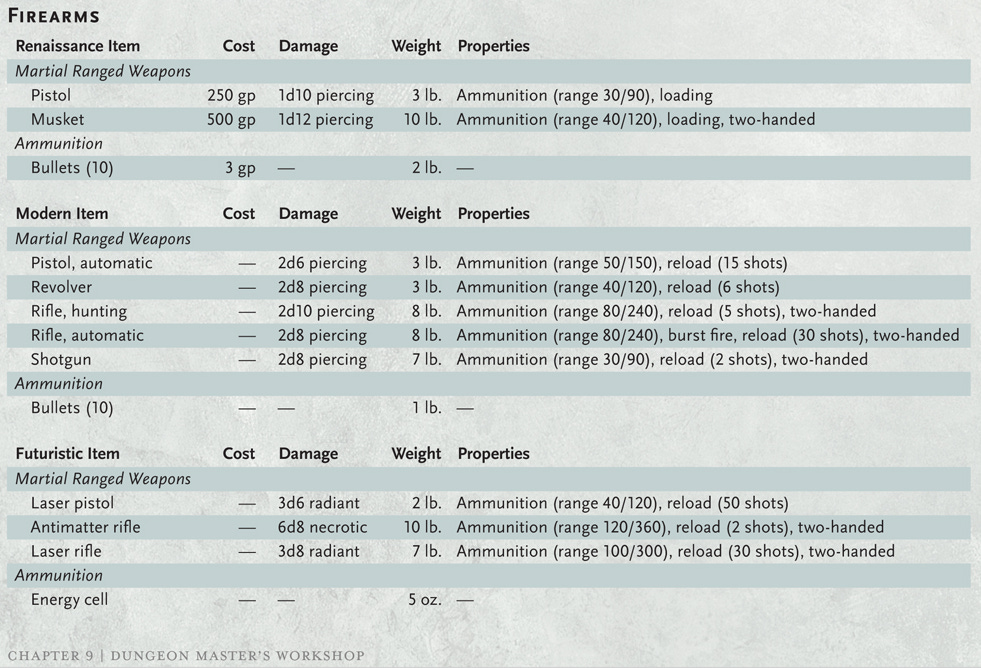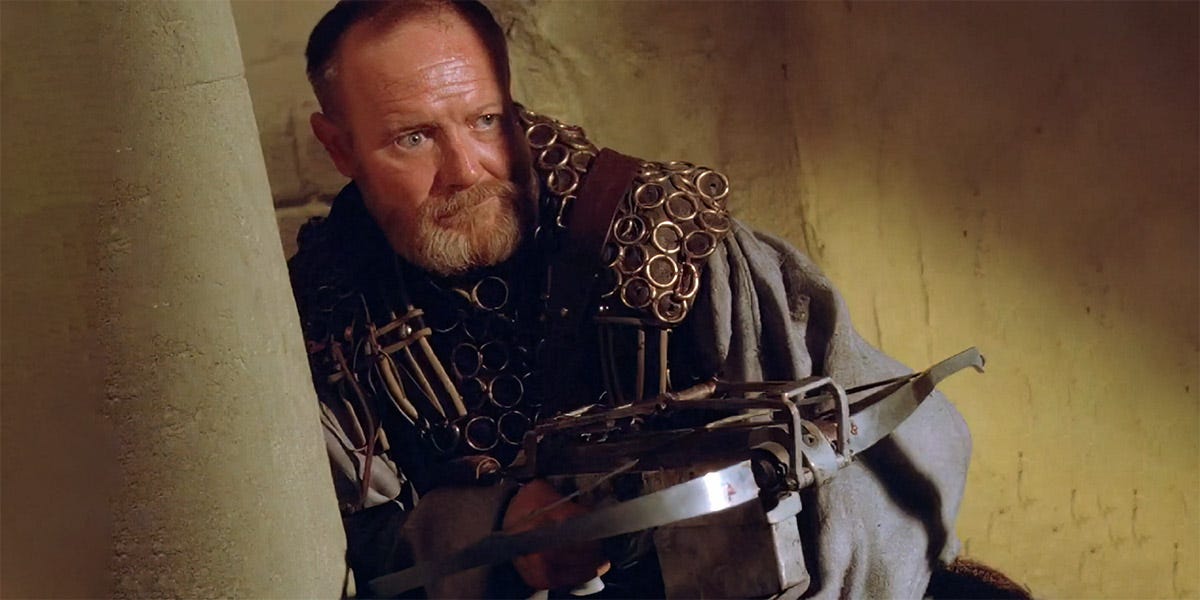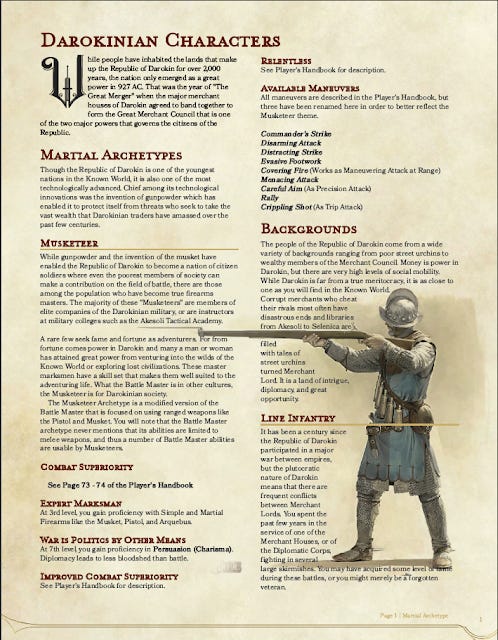Firearms in D&D -- Blackpowder Fantasy
My Homebrew Rules for Amazing Musketeer Characters
Tinker, Tailor, Dwarf, and Spy: Darokinian Musketeers
When I started playing role playing games in the before times in the not now, I was adamantly opposed to including firearms in my fantasy role playing campaigns. Sure, I knew that cannons were quite common and were used extensively in that most Medieval of conflicts The Wars of the Roses, but they weren’t common in the fiction that I was reading at the time. There were no guns in the Elric saga, the Lord of the Rings, or in the tales of Conan the Barbarian.
My view changed slightly as I began to play first Warhammer Fantasy Battle and then Warhammer Fantasy Roleplay. Those games were influenced by the conflicts of the Holy Roman Empire, the 30 Years War, and Tilea perfectly captured Italian Condottiere conflicting with one another. Landsknechts and pike and musket formations abounded. This experience, combined with my love of the Three Musketeers films and books made me more amenable to firearms in a fantasy game, but I was still resistant to incorporate them into my Dungeons & Dragons play. D&D was still “high fantasy” to me and I didn’t allow guns in my games. In part, because my conceptualization of how to emulate guns was that they would do orders of magnitude more damage than a crossbow.
Then two things happened. Wizards of the Coast released the pulp high adventure fantasy setting Eberron and I read the Powder Mage trilogy by Brian McClellan. From that moment on, it was just a matter of figuring out how to emulate them without making other weapons meaningless.
Looking at the Dungeon Master’s guide, it recommends that Pistols do 1d10 piercing damage and that Muskets do 1d12. Both weapons have the “loading” and “ammunition” qualities which limits how frequently they can be fired.
According to the Player’s Handbook, the loading quality is as follows:
Because of the time required to load this weapon, you can fire only one piece of ammunition from it when you use an action, bonus action, or reaction to fire it, regardless of the number of attacks you can normally make.
Similarly, the ammunition quality states:
You can use a weapon that has the ammunition property to make a ranged attack only if you have ammunition from the weapon. Each time you attack with the weapon, you expend one piece of ammunition. Drawing the ammunition from a quiver, case, or other container is part of the attack (you need a free hand to load a one-handed weapon). At the end of the battle, you can recover half your expended ammunition by taking a minute to search the battlefield. If you use a weapon that has the ammunition property to make a melee attack, you treat the weapon as an improvised weapon (see “Improvised Weapons” later in the section). A sling must be loaded to deal any damage when used in this way.
Wow! That’s a lot of text to say that you need ammunition, you reload as part of an attack action, and that you need a free hand. Given the restrictions caused by the combination of the loading and ammunition qualities, this means that any user of a firearm does more damage dice than someone using a Longbow. It also means that they can only fire one shot per round even if they can attack more than once as a part of an attack action, compared to the Longbow where they can fire a number of times equal to the number of attacks per action. This makes firearms better for lower level and non-warrior characters.
So far it doesn’t look good for my gunpowder fantasy campaign. "Tinker, Tailor, Dwarf, and Spy" takes place in the "Known World" setting that was originally published in the Cook Expert Set of Dungeons & Dragons. While the campaign will start in the northern part of Karameikos, I have plans to have the players wander into Darokin and Glantri. For those who aren't familiar with the Known World, it is a hodge-podge setting that includes an anachronistic combination of cultures ranging from the Roman Empire to Renaissance tech societies. Karameikos, where the players' characters are based, is a high-medieval culture and thus is an ideal starting society for the "default fantasy" campaign. I might also continue developing my own game world which sets the magic and gunpowder Kingdom of D’orn against the Steampowered Mechanical Hordes of the Clockwork Orthodoxy and have them adventure there as well.
As I mentioned above, even though any characters would be based out of a default fantasy kingdom, they will be wandering into Darokin and Glantri which are countries inspired by renaissance level cultures. Darokin is based on renaissance Florence and Genoa with a strict plutocratic government. Glantri is based on renaissance Venice (it’s got a lot of canals) with the country being a "mageocracy" rather than plutocracy. Because any characters in the campaign will likely be traveling into these two nations, I had to ask myself whether or not I wanted to include firearms in my D&D campaign using the above rules which favor guns in the hands of non-warriors. After some back and forth, I decided that I would indeed be introducing characters who use Muskets, Pistols, and Arquebuses, but limiting them to Darokinian society. If I use my homebrew campaign, guns will be more widely available.
In preparation for this move, I purchased the Tal'Dorei Campaign Setting by Green Ronin in the hopes that it included the rules for the Gunslinger archetype for the Fighter Class. It turns out that it wasn't necessary to purchase the full campaign guide, as Matthew Mercer has been kind enough to provide the Gunslinger rules as a Pay What You Want file. After reading the archetype, I found that it didn't fit exactly what I wanted to have in my games. The Tal'Dorei Gunslinger is closely based on the Pathfinder Gunslinger character class from the Pathfinder Ultimate Combat Guide and as cool as that class it, it comes with all of the "fiddliness" of the Pathfinder system. Matthew Mercer's Gunslinger kept that fiddliness and I wanted a class that fit with the simplicity of 5th edition.
In the end, I read through the existing archetypes and feats in 5th edition and realized that I didn't need to come up with an entirely new archetype or create new feats. All I needed to do was reskin some existing rules to fit the theme. You see Crossbows currently have the same limitations as firearms, having both the loading and ammunition qualities, and 5e provides a workaround for players who want to play the repeating-crossbow wielding power house from Hawk the Slayer.
With this knowledge I can make the first reskin in order to incorporate musketeers into my game. Musketeers will use a feat that I will call the Blackpowder Marksman feat. The feat will be identical to the Crossbow Expert feat on page 165 of the 5th Edition Player's Handbook, except that it will apply to firearms instead of crossbows. I might possibly limit it to a single kind of firearm.
The Crossbow Expert feat is pretty powerful and makes crossbow using Fighters extremely powerful options in 5e. A key element is the first benefit which lets those who possess the feat to "ignore the loading quality of crossbows with which you are proficient." In other words, it allows crossbow using Fighters to attack more than once when using an Attack action, making them as dangerous with Crossbows and they might be with Longbows. I think that it was fair to have a feat that applies all of these benefits to a person who uses black powder weapons, but only if I adjust the damage of black powder weapons.
While I don't want to spend any real time getting into the weeds of the Arquebus > Crossbow > Longbow > Shortbow argument, I will share the reasons for why I am happy with this quick fix. First, as argued effectively by Richard Berg in his wargame Arquebus, while the longbow's effectiveness had been reduced by the innovation of plate armor, "crossbows took more time to wind and fire than an arquebus, which had similar penetrative abilities but a far lower rate of fire." Looking at the stats for the crossbow and comparing them to the longbow, we see that these attributes are taken into account in 5e. The heavy crossbow does 1d10 damage and requires reloading while the longbow does 1d8 and doesn't. The Crossbow Expert feat allows a Fighter to use a crossbow with the same rate of fire as a longbow, something ahistorical but perfect for fantasy. In D&D a combat round is only 6 seconds long and a high level Fighter can shoot his longbow 8 times in a combat round (and thus a crossbow 8 times). That's not at all realistic, but it allows the damage curve to keep up with mages and hand to hand combatants. This is high fantasy after all and limiting arquebus/musket use to 4 shots per minute might be accurate, but it wouldn't be fun. So long as you keep the damage for the black powder weapons within reason (which the DMG does), game balance is retained. Though to retain balance, I will shift the damage dice down one step for each weapon. This means that muskets do 1d10 damage like a heavy crossbow and pistols do 1d8 damage in my game.
Once I made this slight concession to fun over fact, I began looking to the character class archetypes to see how they fit the model of Musketeer. What I found was that two of the archetypes in the Player's Handbook reskinned nicely to be gun toting characters. I was especially impressed with how the Battle Master archetype fit for Musketeers. Since only a few of the maneuvers for the Battle Master specified "melee weapon," it meant that these abilities could be used with missile weapons with only minimum change. I might mention here that the designers Baldur’s Gate 3 also noticed this fact and that the Bow Wielding Battle Master is a wonderful thing in that game.
Based on all this reasoning, I wrote up a rules page using The Homebrewery that included the Musketeer archetype based on the Battle Master. I haven't stated up the Eldritch Knight version, but if one limits the spell list properly it's easy to see spell as "magic ammunition." You can download the file below.
Lastly, I created a background that would allow even non-Fighters to be proficient in "simple" black powder weapons and classified the arquebus as a simple weapon with the pistol and musket counting as martial weapons in Darokinian Society.









Some people think they can outsmart me. Maybe, maybe. I've yet to meet one that can outsmart bullet. - Heavy Weapons Guy